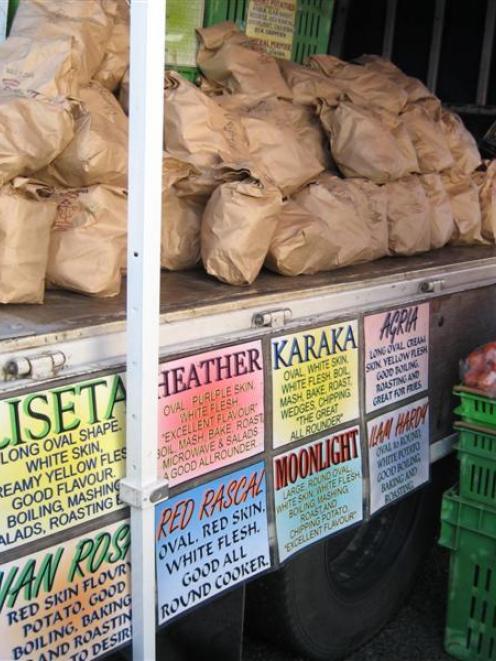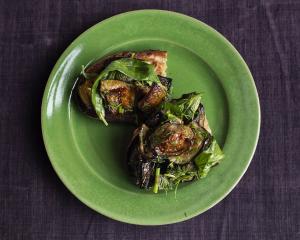
Although potatoes originated in the Andes in South America, they have spread round the world.
Surprisingly, China and India are now two of the largest potato-producing countries. However, northeastern European countries and, unexpectedly, Rwanda consume most potatoes per capita.
The United Nations, at the prompting of Peru, is promoting potatoes as one of the answers to world hunger - the potato produces more nutritious food more quickly, on less land, and in harsher climates than any other major crop.
Up to 85% of the plant is edible human food, compared to about 50% in cereals.
In the 19th century, the poor Irish managed to live off potatoes, eating, according to Alan Davidson in the Oxford Companion to Food, an average of 7lb to 14lb (3.5kg-7kg) a day, along with a bit of milk or buttermilk and salt.
In lean times they ate "potatoes and point" - eating boiled potatoes while pointing to the bacon smoking in the rafters overhead which was only to be enjoyed on festive days.
However, at the time Ireland relied on only a few potato varieties which were not resistant to blight. In 1845-46 blight destroyed the crop. An estimated one million people starved to death and more than a million were forced to migrate.
To prevent a repeat and to combat pests and diseases, increase yields, and sustain production on marginal lands, a continuous supply of new varieties is needed, according to the UN.
That requires access to the entire potato gene pool and the greatest genetic variety is to be found in its homeland, the Andes.
However, potato biodiversity is under threat there: ancient varieties cultivated by Andean peoples for millennia have been lost to diseases, climate change and social upheaval.
The International Potato Centre in Peru now works with indigenous people to preserve the biodiversity and the intellectual property rights of the many varieties of potato and related species native to the area.
Varieties
Many potato varieties are available locally.
Supermarkets have several varieties, but some of the less common ones, like the wonderfully purple urenika, can be found at the Otago Farmers Market on Saturday mornings at the Dunedin Railway Station.
There are even more varieties available to home gardeners.
Adam and Jo-Ann Paterson who run Matheson and Roberts, which has been in operation since 1919, sell heritage varieties such as lady finger, red rocks, gladstone, pink fir apple, Arran chief and Scott salad blue.
Some of these and seeds of other vegetables have been with the firm for years, but others had been given them, and with access to seed catalogues from the 1920s and '30s they have been able to identify and produce both potatoes for eating and for seed.
Heritage varieties do not crop as heavily as modern varieties, says Mrs Paterson, and they
have to be hand dug, but they have good flavours.
"Maori" potatoes, such as urenika, moemoe peruperu, karupoti, kowiniwini, are old varieties of potato introduced by early explorers, sealers and whalers and widely cultivated by Maori in the late 18th and 19th centuries.
Many home gardeners are growing them as something different, and they are sometimes available from farmers markets, like the purple urenika.
It is hard to find a complete list of varieties available here, but here are some that are available locally at the moment, suggested by Heather Preedy, of Ettrick Gardens, Ray Goddard, both with stalls at the market, Cyril Torrance, of MG Marketing and Gilbert Wong, of Centre City New World.
Texture
Potatoes range in texture from floury to waxy, depending not only on variety, but also on time of year and where they are grown.
- Floury varieties are softer and break up more easily during cooking. They are best suited to mashing, roasting, chips, wedges and for thickening soups.
- Agria has yellow flesh and lovely flavour. They are good for roasting and mash.
- Urenika has dark purple, almost black skin and bright purple flesh and makes the most amazing coloured mash or wedges. It is one of the old varieties grown by Maori and early settlers. Red king is good for mashing and roasting.
- All-purpose varieties are near the mid-point between waxy and floury, making them suitable for most uses.
- Desiree has a smooth pinky-red skin with pale yellow flesh. They are readily available in supermarkets.
- Karaka has white skin and flesh and a good flavour.
- Maris anchor has white flesh, good flavour, and makes a lovely fluffy mash.
- Rua has good flavour and makes a very white mash but doesn't break up when boiling.
- Moonlight is a versatile potato.
- Van rosa is a yellow-fleshed potato with good flavour, suitable for boiling and roasting Red rascal is an all-purpose potato tending to waxy and is good for baking.
- Waxy varieties are firmer and hold their shape during cooking, making them suitable for boiling, salads, casseroles and soups where you want them to keep their shape. New potatoes are waxy.
- Nadine is sometimes called the dumb blonde of potatoes, because it looks nice and has good texture but little flavour. It is widely found in supermarkets.
Potatoes are good for you
Potatoes are rich in carbohydrates, making them a good source of energy.
They have the highest protein content (around 2.1% on a fresh weight basis) in the family of root and tuber crops, and protein of a fairly high quality, with an amino-acid pattern that is well matched to human requirements.
In addition, the potato is low in fat.
Potatoes are rich in several micronutrients, especially vitamin C - eaten with its skin, a single medium sized potato of 150g provides nearly half the daily adult requirement (100mg).
The potato is a moderate source of iron, and its high vitamin C content promotes iron absorption. It is a good source of vitamins B1, B3 and B6 and minerals such as potassium, phosphorus and magnesium, and contains folate, pantothenic acid and riboflavin.
Potatoes also contain dietary antioxidants, which may play a part in preventing diseases related to ageing, and dietary fibre, which benefits health.
Potatoes should be stored in a dark, cool place. Under exposure to light, they turn green and develop a bitter-tasting toxin.
Any green parts should be cut out before cooking (new potatoes have a greater tendency to turn green than main crop potatoes).
On the web













